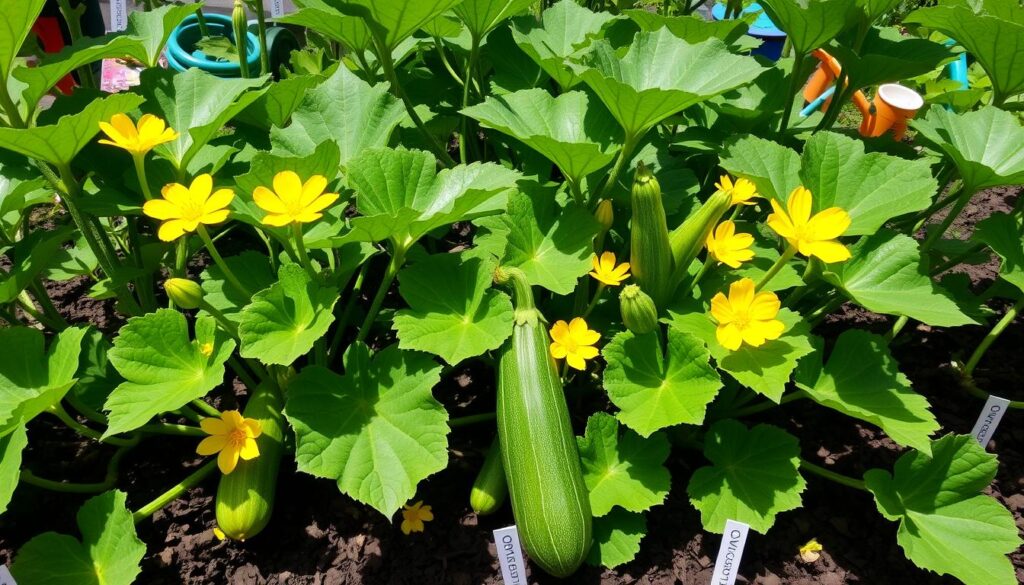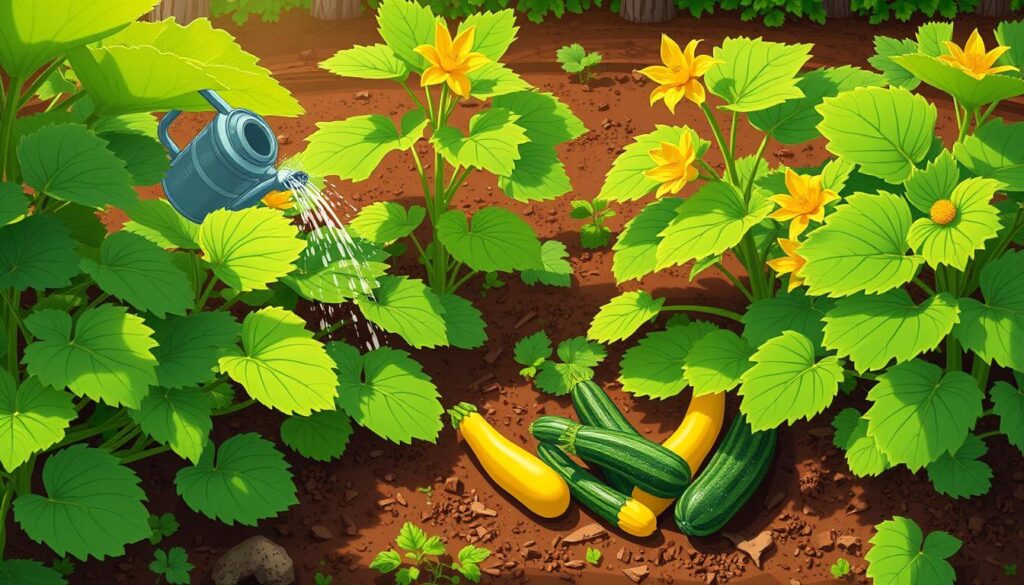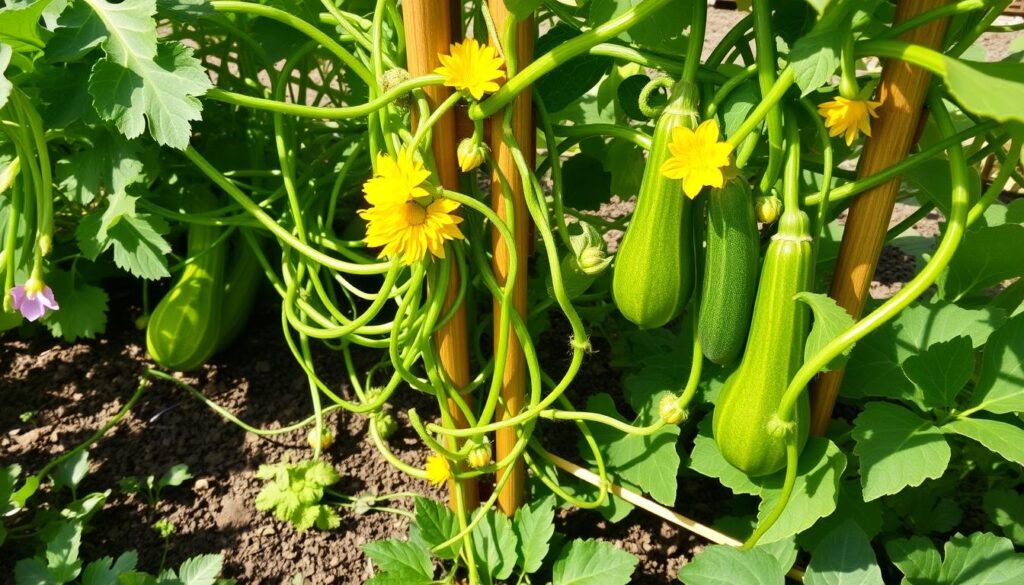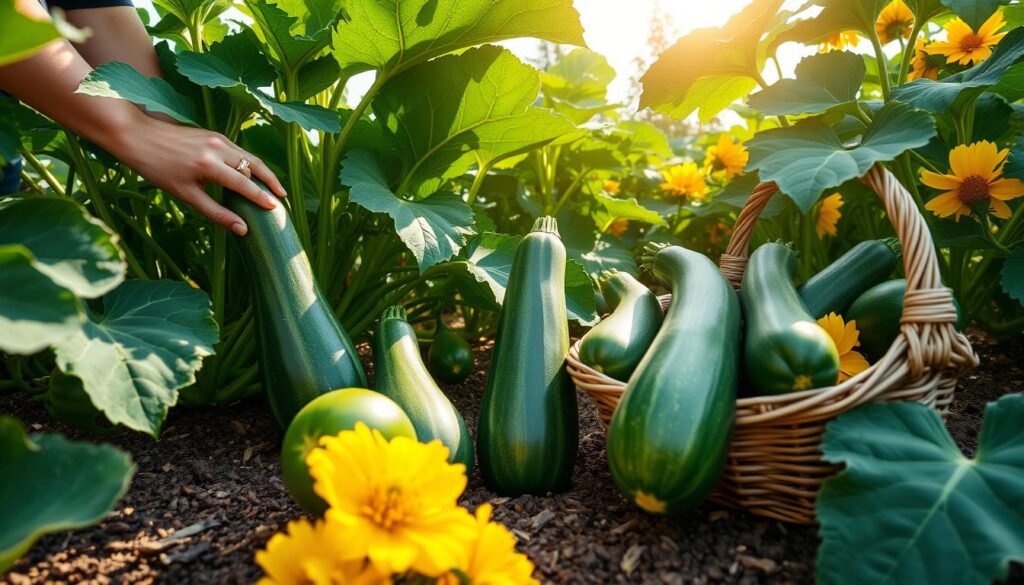Welcome to our guide on How to Grow Zucchini. We’ll cover everything you need to know for a bountiful harvest. Growing zucchini is rewarding, giving you fresh, nutritious veggies all season. With our tips, you’ll have a successful harvest.
We aim to give you the best start growing zucchini. Our expert advice will help you succeed, whether you’re new or experienced. We’ll guide you from choosing the right variety to storing your harvest.
Key Takeaways
- Learn the basics of How to Grow Zucchini with our guide
- Discover the best Zucchini Growing Tips for a bountiful harvest
- Get started with growing your own zucchini, even with limited experience
- Understand the importance of proper care and maintenance for your zucchini plants
- Enjoy a successful harvest with our expert advice and guidance
- Find out how to store and preserve your zucchini for year-round enjoyment
Getting Started with Zucchini Cultivation
Starting to grow zucchini plants is exciting and rewarding. It’s key to begin with the right steps. This means picking the best zucchini variety, knowing the growing season, and having the right tools. A good Zucchini Planting Guide will help you grow a lot of tasty zucchinis.
When growing zucchini, think about space, harvest time, and what you like. Popular varieties include ‘Black Beauty’, ‘Golden’, and ‘Round’. Knowing the growing season helps you plant at the best time and care for your plants.
Best Zucchini Varieties for Home Gardens
- ‘Black Beauty’: A popular and versatile variety, known for its dark green skin and tender flesh.
- ‘Golden’: A yellow-skinned variety, perfect for adding a burst of color to your dishes.
- ‘Round’: A compact and space-saving variety, ideal for smaller gardens.
Essential Tools and Materials
To start growing zucchini, you’ll need some basic tools and materials. These include seeds, soil, fertilizer, and a watering can. Having these basics helps your zucchini plants grow well.
Selecting the Perfect Growing Location
Choosing the right spot for your zucchini is key to a great harvest. Zucchini needs full sun to partial shade and well-drained soil. Make sure your spot gets enough sunlight and has good soil.
Key factors to consider include the land’s slope, how close it is to water, and if it’s protected from wind. These help create the best spot for your zucchini.
Remember crop rotation and companion planting when picking a spot. These methods help your plants grow well together. They make your garden balanced and healthy.
With the right spot and gardening techniques, your zucchini garden will thrive. Keep an eye on your plants and adjust as needed for a great harvest.
Soil Preparation and Requirements
Soil preparation is key for growing zucchini well. To make a great spot for zucchini, focus on the soil’s health. You want a soil that helps your plants grow strong and healthy.
Zucchini likes soil with a pH between 6.0 and 7.0. To get this, you might add compost or manure. These natural helpers change the soil’s pH and make it richer, helping your zucchini plants grow well.
Key Considerations for Soil Preparation
- Soil pH levels: aim for a range between 6.0 and 7.0
- Soil amendment techniques: use compost or manure to adjust pH and improve fertility
- Drainage considerations: ensure good drainage to prevent waterlogged soil
By following these tips, you can make your soil perfect for zucchini. Always check your soil and adjust it if needed to keep it healthy.
How to Grow Zucchini from Seeds
Growing zucchini from seeds is easy but needs careful planning. First, pick good-quality seeds. Then, prepare the soil as the Zucchini Care Guide suggests. Plant the seeds about 1 inch deep and 2-3 inches apart. Make rows 3-4 feet apart.
Keep the soil moist during germination, which takes 3-10 days. It’s key to have a stable temperature and enough sunlight. Here are some important tips:
- Use a well-draining potting mix to prevent waterlogged soil
- Provide support for the plants as they grow, using a trellis or cage
- Keep the area around the plants weed-free to prevent competition for nutrients
By following these steps and using a Zucchini Care Guide, you’ll grow healthy zucchini plants from seeds.

Transplanting Young Zucchini Plants
Transplanting young zucchini plants is key to their growth. It’s important to think about spacing and timing. When you transplant, handle the roots gently and don’t mess with the soil around the plant.
Following Zucchini Plant Care Instructions for transplanting is vital. Make sure to give plants enough space, about 12-18 inches apart. This prevents overcrowding and helps with air circulation. It also keeps diseases and pests away, which can harm the plant.
Proper Spacing Guidelines
- Space plants 12-18 inches apart to prevent overcrowding
- Provide adequate air circulation to promote healthy growth
- Avoid planting in areas with standing water or poor drainage
Best Time for Transplanting
The best time to transplant zucchini plants depends on the weather and their hardiness. It’s best to transplant when they have 2-3 sets of leaves. This lets them develop a strong root system before facing outdoor conditions.
By following these tips and Zucchini Plant Care Instructions, you can ensure a successful transplant. Keep an eye on your plant’s growth and adjust your care as needed. This will help your zucchini plant thrive.
Watering Techniques for Healthy Growth
Watering is key when you’re growing zucchini. These plants need steady moisture, more so when they’re fruiting. To get this right, water them deeply but not too often. This encourages strong roots.
Check the soil’s moisture by feeling the top inch. If it’s dry, it’s time to water. This method stops you from overwatering, which can harm the roots. Here are some tips:
- Water your zucchini in the morning. This lets the plants soak up the water all day.
- Don’t splash water on the leaves or crown. This can cause fungal diseases.
- Try using a soaker hose or drip irrigation. They water the roots directly.

By using these watering tips, you’ll grow healthy zucchini. Keep an eye on your plants and adjust your watering as needed. This will help you succeed in growing zucchini.
Fertilizing Your Zucchini Plants
Fertilizing is key for Zucchini Growing Tips. It helps your plants grow strong and produce more. Organic fertilizers are great because they’re good for the environment and the soil.
Compost tea, fish emulsion, and well-rotted manure are top picks. They’re full of nutrients and can be used at different times. For example, compost tea helps leaves grow, while fish emulsion boosts roots.
Organic Fertilizer Options
- Compost tea: a liquid solution made by steeping compost in water
- Fish emulsion: a liquid fertilizer made from fish waste
- Well-rotted manure: a solid fertilizer made from animal waste
Feeding Schedule and Requirements
The right time to feed your zucchini plants depends on the fertilizer and plant stage. Start when they’re 6-8 inches tall. Then, feed again when they start flowering and fruiting. A balanced fertilizer with a 10-10-10 ratio works well.
By using these Zucchini Growing Tips and the right fertilizers, your zucchini garden will thrive. Always follow the fertilizer instructions and avoid over-fertilizing to protect your plants.
| Fertilizer Type | Application Rate | Frequency |
|---|---|---|
| Compost tea | 1-2 cups per plant | Every 1-2 weeks |
| Fish emulsion | 1-2 tablespoons per gallon of water | Every 1-2 weeks |
| Well-rotted manure | 1-2 inches per plant | Every 2-3 months |
Supporting and Training Zucchini Vines
When growing zucchini, it’s key to support and train the vines. This helps increase yields and uses garden space well. As vines grow, they can get long and messy. So, it’s important to manage them.
Trellising Methods
Using a trellis is a great way to support zucchini vines. You can choose from simple fences to complex trellis systems. Teepees or cages also work well. The goal is to give vines something to climb on.

Pruning Techniques
Pruning is vital for zucchini vines. It helps control plant size, promotes fruiting, and removes diseased leaves. Here are some pruning tips:
- Remove weak or spindly growth
- Cut back vine tips to encourage branching
- Take off leaves touching the ground to prevent disease
By pruning and using the right trellising, your zucchini vines will thrive. You’ll enjoy a rich harvest of tasty zucchini.
Managing Common Pests and Diseases
Zucchini gardening techniques are key to stopping pests and diseases. It’s important to check plants often to catch problems early. Using organic pest control methods and companion planting can help a lot. Common pests include aphids, whiteflies, and squash bugs.
To fight these pests, try crop rotation and physical barriers. Also, natural pest control methods like neem oil and insecticidal soap work well. Keeping your garden clean by removing sick plants is also vital.
Zucchini plants can get diseases like powdery mildew, fungal infections, and bacterial wilt. To avoid these, make sure to water right and keep air moving. By doing these things and staying alert, you can have a great zucchini harvest.
Pollination and Flower Care
Pollination is key for zucchini growth. Knowing the best practices can boost your yield. Zucchini plants have separate male and female flowers, making pollination a bit tricky.
It’s important to learn about pollination methods and flower care. Hand pollination is a good option, helping when bees are scarce.
Hand Pollination Methods
Hand pollination uses a small brush to move pollen. It’s a bit of work but ensures flowers are pollinated.
Attracting Natural Pollinators
Bees and other pollinators are great for zucchini. Planting various flowers near your zucchini can attract them. Flowers like sunflowers, zinnias, and cosmos are good choices.
| Method | Description |
|---|---|
| Hand Pollination | Transferring pollen from male to female flowers using a brush |
| Natural Pollinators | Attracting bees and other pollinators using diverse flowers |
Companion Planting Strategies
Companion planting is key in a Zucchini Care Guide. It means planting different species together to help each other grow. This way, you can make your garden a balanced and thriving place.
Some plants, like nasturtiums, radishes, and marigolds, keep pests away from zucchini. This means you use fewer pesticides and keep your garden healthy. Other plants, like corn and beans, help zucchini plants grow strong by providing support.
Best Plant Companions
- Nasturtiums: repel aphids, whiteflies, and other pests
- Radishes: repel cucumber beetles and other pests
- Marigolds: repel nematodes and other pests
- Corn: provides structural support and shade
- Beans: provides structural support and fixes nitrogen in the soil
Plants to Avoid
But, some plants don’t get along with zucchini. Plants like potatoes, tomatoes, and okra can spread diseases. This can harm your zucchini plants.
By using a good companion planting plan, you can have a great zucchini garden. This method helps your zucchini plants grow well. It also makes your garden more balanced and sustainable.
| Companion Plant | Benefits |
|---|---|
| Nasturtiums | Repels aphids, whiteflies, and other pests |
| Radishes | Repels cucumber beetles and other pests |
| Marigolds | Repels nematodes and other pests |
Harvesting Your Zucchini
Harvesting your zucchini is the rewarding culmination of your hard work. To make the most of your Zucchini Harvesting Tips, it’s essential to know when your zucchini is ready to be picked. Zucchini is typically ready to harvest when it reaches 6-8 inches in length and the skin is tender.
Regular harvesting encourages the plant to produce more fruit, so it’s important to check your plants often. The best time to harvest is early in the morning, when the dew is on the plants. Here are some additional Zucchini Harvesting Tips to keep in mind:
- Use a sharp knife or pruning shears to avoid damaging the plant
- Harvest zucchini regularly to promote continuous production
- Check for any signs of pests or diseases before harvesting

By following these Zucchini Harvesting Tips, you’ll enjoy a bountiful harvest of delicious and healthy zucchini. Always handle your zucchini with care. Store it properly to maintain its freshness and quality.
Storage and Preservation Methods
Keeping your zucchini fresh is key. Follow the Zucchini Plant Care Instructions to enjoy it longer. Store it in a cool, dry spot or in the fridge to keep it fresh.
Freezing and processing are great for longer storage. Blanching before freezing keeps the zucchini’s nutrients and texture. Here are some tips for preserving your zucchini:
- Blanching: Submerge the zucchini in boiling water for 2-3 minutes to inactivate enzymes that can cause spoilage.
- Freezing: Package the blanched zucchini in airtight containers or freezer bags to preserve it for up to 8 months.
- Processing: Use your zucchini in soups, stews, or bread recipes to enjoy it throughout the year.
By using these storage and preservation tips, you can enjoy your zucchini for a longer time. This way, you get the most out of your Zucchini Plant Care Instructions.
Conclusion: Growing Success with Your Zucchini Garden
Growing a thriving zucchini garden takes patience and dedication. By following our guide, you’re on your way to a bountiful harvest. Enjoy the delicious and nutritious zucchini you’ll grow.
Stay flexible and adapt to your garden’s unique conditions. Try new zucchini varieties and growing methods to improve. With the right approach, you’ll have a zucchini oasis that never ends.
Whether you’re new or experienced, growing zucchini is all about understanding the plant’s needs. Provide the best care and watch out for pests and diseases. Follow our tips to harvest a lot of zucchini that tastes great and is good for you.
Happy zucchini growing! Enjoy the fruits of your labor!
FAQ
What are the best zucchini varieties for home gardens?
Top picks for home gardens include ‘Black Beauty’, ‘Costata Romanesco’, ‘Eight Ball’, and ‘Raven’. These zucchinis are known for their high yield, disease resistance, and delicious taste.
When is the best time to plant zucchini?
Plant zucchini in the spring or early summer, after the frost is gone. The soil should be between 70-85°F for planting.
What type of soil do zucchini plants prefer?
Zucchini loves well-drained, rich soil with a pH of 6.0 to 7.0. Adding compost or aged manure can make the soil better for them.
How often should I water my zucchini plants?
Keep zucchini plants moist, about 1-2 inches a week. Adjust how often you water based on the weather and how fast they grow.
How do I encourage pollination and fruit production?
Help pollination by hand-pollinating or attracting bees. Planting flowers that attract pollinators can also help.
How do I know when to harvest zucchini?
Zucchini is ready when it’s 6-8 inches long and the skin is soft. Harvest in the morning for the best taste and texture.
How can I store and preserve my zucchini harvest?
Store zucchini in the fridge for up to 5 days. To keep it longer, freeze, pickle, or dehydrate it. Blanching before freezing keeps it fresh.
What are some common pests and diseases that affect zucchini plants?
Pests like cucumber beetles, squash bugs, and aphids can harm zucchini. Diseases like powdery mildew and bacterial wilt are common too. Use good garden practices and pest management to fight these problems.
Share this post: on Twitter on Facebook

